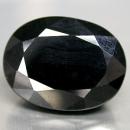|
|
|
|
Click on a letter above to view the list of gems. |
|
|
|
|
|
Schorl
(Black
variety
of Tourmaline) |
|
| Chemistry:
NaFe3+3Al6(BO3)3Si6O18(OH)4 | |
| Discovered
prior to 1400;
IMA
status: Valid (pre-IMA; Grandfathered). | ||
|
| ||
|
Classification |
|
|
| |
|
Silicates | |
|
8/E.19-50 | |
|
|
9 : SILICATES (Germanates) |
|
Related to: |
Tourmaline Group. Elbaite - Schorl Series. Dravite - Schorl Series. |
|
|
|
|
Crystal Data |
|
|
|
|
|
Crystals prismatic to acicular, or may be flattened along [0001], with prominent trigonal prism and pyramid, to 1.5 m. Commonly hemimorphic, and striated [0001]. Also radial, fibrous, and massive. |
|
|
Rarely on [1010], [4041]. |
|
|
|
|
|
Physical Properties |
|
|
|
|
|
[1120] very Poor, [1011] very Poor |
|
|
Uneven to Conchoidal |
|
|
Brittle |
|
|
7.0 |
|
|
3.18 - 3.22 (g/cm3) |
|
|
None |
|
|
Not Radioactive |
|
|
Other: | |
|
|
|
|
Optical Properties |
|
|
|
|
|
Black, Brownish Black, Greenish Black, Bluish Black |
|
|
Opaque |
|
|
Vitreous to Resinous |
|
|
1.635 - 1.672 Uniaxial ( - ); under strain may show slight Biaxiality |
|
|
0.0270 - 0.0320 |
|
|
0.017 |
|
|
Very strong; O = yellow-brown; E = pale yellow, pale brown |
|
|
|
|
|
Occurances |
|
|
|
|
|
Geological Setting: |
In granites and granite pegmatites, high-temperature hydrothermal veins, and some metamorphic rocks; also detrital. |
|
Common Associations: |
Albite, Beryl, Cassiterite, Epidote, Fluorite, Garnet, Microcline, Muscovite, Orthoclase, Quartz, Scheelite, Topaz |
|
Common Impurities: |
Mn, Mg, Ca, Li, Cr, Ti, F, K |
|
Type Locality: |
Possibly Zschorlau (Schürl), Saxony, Germany |
|
Year Discovered: |
prior to 1400 AD |
|
View mineral photos: | |
|
|
|
|
More Information |
|
|
|
|
|
| |
|
|
|
|
In addition to being found as independent mineral crystals, Schorl is also found as long thin crystal inclusions in Quartz, forming "Tourmalinated Quartz". These black crystals, or "needles", create very attractive and collectable Quartz gems. The name Schorl may be derived from Zschorlau, the name of a village in Saxony, Germany which was named Schorl, or Schürl, prior to 1400 AD. The name may have come from the Old German SchÄurl or Schürl, of uncertain derivation, perhaps meaning impurities because Black Tourmaline was abundant in a nearby tin mine which also contained Cassiterite. The name Tourmaline is from the Singhalese word tourmali,
meaning mixed colored stones because Tourmalines
were often confused with other gems because of the variety
of colors. Tourmaline
is the name given to a family of related minerals, all
having the same basic crystal structure but varying
widely in chemical composition. Tourmaline comes in
just about all colors including colorless (Achroite) and black
(Schorl) with many names given to the many other
colors.
|
|
|
We
have not photographed our Schorl gems. Please
check back soon. |
